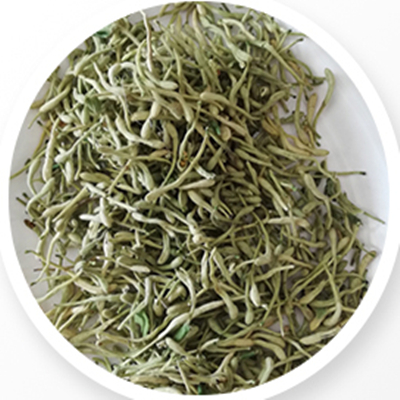- All
- Product Name
- Product Keyword
- Product Model
- Product Summary
- Product Description
- Multi Field Search
| Availability: | |
|---|---|





Herbal Leaf &Flower &Stem
NatureChoice
210
English Name: Honey suckle flower
Chinese Name: Jinyinhua
Botanical Name: Lonicera japonica Thunb.
Part: Flower
Color: Green & Brwon-yellow
Original place : Planted Honey suckle flower: Henan, Shandong province; Wild Honey suckle flower: Shaaxi Province
This product is the dried flower buds or flowers with first bloom of Lonicera japonica. It is harvested before the flowers open in early summer and dried. Honeysuckle is sweet and cold in nature, aromatic and dispersing, clears heat without hurting the stomach. Honeysuckle belongs to the lung and stomach meridians. Honeysuckle is good at dispersing wind-heat and clearing heat and detoxification, and is used for various febrile diseases, such as generalized dryness and heat, warm poisonous spots, rashes, sore throats, and feverish sores and carbuncles. Honeysuckle can be made into honeysuckle lotion, honeysuckle powder, honeysuckle soup, which is convenient for different people to take, and can also be taken in appropriate amounts and poured onto the affected area.
The product is rod-shaped, thick on the lower thin, slightly curved, 2-3cm long, about 3mm in diameter above, about 1.5mm in diameter below. surface yellow-white or green-white (storage for a long time the color darkens), densely pubescent. Occasionally see leaf-like bracts. Calyx green, apex 5-lobed, lobes hairy, ca. 2 mm. open corolla cylindrical, apex 2-lipped; stamens 5, attached to the tube wall, yellow; pistil 1, ovary glabrous. Scent fresh, taste light, slightly bitter.
Moisture shall not be more than 12.0%.
Total ash shall not be more than 10.0%.
Acid insoluble ash shall not be more than 3.0%.
Heavy metals and harmful elements according to the lead, cadmium, arsenic, mercury, copper determination method (General 2321 atomic absorption spectrophotometry or inductively coupled plasma mass spectrometry) determination, lead shall not exceed 5mg/kg; cadmium shall not exceed l mg/kg; arsenic shall not exceed 2mg/kg; mercury shall not exceed 0.2mg/kg; copper shall not exceed 20mg/kg.
Honeysuckle contains active ingredients such as dahurin, inositol, saponins, and tannins.
1. Anti-inflammatory effect: honeysuckle contains anti-inflammatory components, but also can promote the release of adrenocorticotropic hormone, so as to effectively inhibit the occurrence of various inflammatory diseases.
2. Hypolipidemic effect: drinking water with honeysuckle is conducive to reducing serum cholesterol content, which helps to remove fat from blood vessels and increase vascular blood flow, thus preventing hypertension, hyperlipidemia, atherosclerosis, myocardial infarction and other symptoms.
3. Enhance the role of the body's immunity: honeysuckle to promote can enhance the phagocytosis of white blood cells, can also promote the body's metabolic capacity, thereby enhancing the body's resistance.
Food industry; beauty industry; pharmaceutical industry
English Name: Honey suckle flower
Chinese Name: Jinyinhua
Botanical Name: Lonicera japonica Thunb.
Part: Flower
Color: Green & Brwon-yellow
Original place : Planted Honey suckle flower: Henan, Shandong province; Wild Honey suckle flower: Shaaxi Province
This product is the dried flower buds or flowers with first bloom of Lonicera japonica. It is harvested before the flowers open in early summer and dried. Honeysuckle is sweet and cold in nature, aromatic and dispersing, clears heat without hurting the stomach. Honeysuckle belongs to the lung and stomach meridians. Honeysuckle is good at dispersing wind-heat and clearing heat and detoxification, and is used for various febrile diseases, such as generalized dryness and heat, warm poisonous spots, rashes, sore throats, and feverish sores and carbuncles. Honeysuckle can be made into honeysuckle lotion, honeysuckle powder, honeysuckle soup, which is convenient for different people to take, and can also be taken in appropriate amounts and poured onto the affected area.
The product is rod-shaped, thick on the lower thin, slightly curved, 2-3cm long, about 3mm in diameter above, about 1.5mm in diameter below. surface yellow-white or green-white (storage for a long time the color darkens), densely pubescent. Occasionally see leaf-like bracts. Calyx green, apex 5-lobed, lobes hairy, ca. 2 mm. open corolla cylindrical, apex 2-lipped; stamens 5, attached to the tube wall, yellow; pistil 1, ovary glabrous. Scent fresh, taste light, slightly bitter.
Moisture shall not be more than 12.0%.
Total ash shall not be more than 10.0%.
Acid insoluble ash shall not be more than 3.0%.
Heavy metals and harmful elements according to the lead, cadmium, arsenic, mercury, copper determination method (General 2321 atomic absorption spectrophotometry or inductively coupled plasma mass spectrometry) determination, lead shall not exceed 5mg/kg; cadmium shall not exceed l mg/kg; arsenic shall not exceed 2mg/kg; mercury shall not exceed 0.2mg/kg; copper shall not exceed 20mg/kg.
Honeysuckle contains active ingredients such as dahurin, inositol, saponins, and tannins.
1. Anti-inflammatory effect: honeysuckle contains anti-inflammatory components, but also can promote the release of adrenocorticotropic hormone, so as to effectively inhibit the occurrence of various inflammatory diseases.
2. Hypolipidemic effect: drinking water with honeysuckle is conducive to reducing serum cholesterol content, which helps to remove fat from blood vessels and increase vascular blood flow, thus preventing hypertension, hyperlipidemia, atherosclerosis, myocardial infarction and other symptoms.
3. Enhance the role of the body's immunity: honeysuckle to promote can enhance the phagocytosis of white blood cells, can also promote the body's metabolic capacity, thereby enhancing the body's resistance.
Food industry; beauty industry; pharmaceutical industry